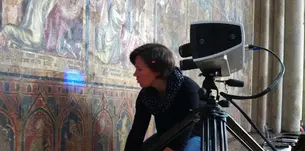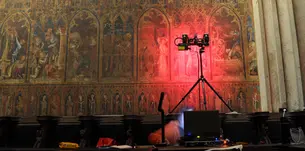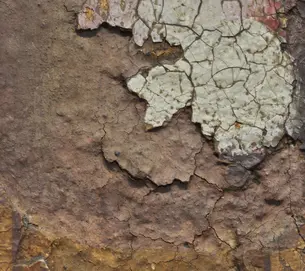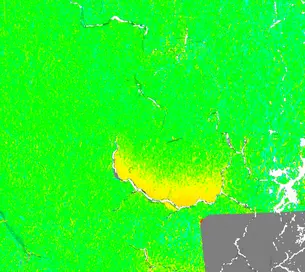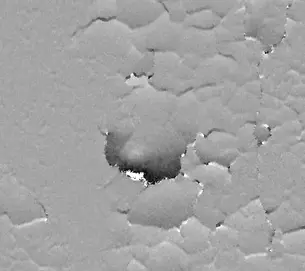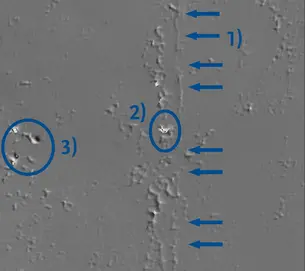Monitoring of Historical Surfaces using Shearography and Structured Light Scanning
Content and aims
The 14th century choir screen paintings in Cologne Cathedral are considered fragile and endangered. Problems arise from the hygroscopic preservatives used in the 20th century and the climatic situation in the cathedral. With a strongly fluctuating relative humidity above 60 % in combination with fluctuating temperatures, damaging processes are unavoidable.
As a basis for planned conservation measures, monitoring for the analysis and monitoring of the endangered historic surfaces on the choir screens, consisting of a novel combination of two non-destructive testing methods NDTs (Shearography and Structured Light Scanning), was carried out.
Methodology
Shearography
Shearography (Digital Speckle Shearing Interferometry) is a laser optical micrometer technique that uses light as a scale for determining surface topographic changes. In a controlled double exposure process, with shifted ("sheared") images, surface measurements are compared after brief stimulation with vacuum, sound waves or temperature. Here, the degree of deformation or elongation of materials and layers, by interferometric methods, can be visualized and determined. For investigations of the choir screen paintings, thermal stimulation of a maximum of 2° K was used as part of the measurements. Shearography is best suited to detect cracks, voids and material differences. During the project, the ISIS 1100 shearography system from Steinbichler was used in conjunction with halogen lamps for thermal stimulation.
Structured Light Scanning
In addition, three-dimensional and high-resolution documentation of the surface topography was carried out by means of structured light scanning. A Comet L3D with a 45 mm measuring field from Steinbichler was used for this purpose. This high-resolution macro measuring field enables surface documentation with a point spacing of up to 18 μm. However, a single measurement only covers an area of approx. 5 x 5 cm. For the documentation of larger areas, such as the monitoring surfaces on the St. Peter's choir screen painting, several individual scans were combined with an overlap of more than 50%. By repeatedly measuring the same area after a longer period of time and then overlaying the surface reliefs, changes such as movements, application or material loss can be specifically recorded and visualized.
Combination of methods
The complementary application of shearography, structured light scanning and photo documentation for monitoring endangered wall paintings showed unexpectedly good and reliable results. Thus, in addition to the detailed documentation of the overall condition of the paintings, it was also possible to detect conservation measures such as the consolidation of individual layers of paint down to a depth of about 4 mm.
For this purpose, the general documentation of the condition was carried out by means of color photography. In this way, damage can be quickly and easily determined and localized, and monitoring areas can then be specifically selected for use with the other measuring techniques. Using 3D surface comparisons, changes and movements in the paintings can be recorded and precisely measured over a longer period of time. This technique also provides clear indications of the extent and direction of movements. For example, the lifting and lowering of paint clods or, for example, a loss of material. However, with Structured Light Scanning it is not possible to look beneath the historical surfaces. This is where the enormous advantage of shearography is found. The short thermal stimulation of the surface allows not only the differentiation of active, inactive or even stabilized cracks, but also the detection of voids in depths up to 4 mm. However, the direction or extent of movement cannot be determined metrically using shearography.
As the example of the tempera painting of the St. Peter's choir screen at Cologne Cathedral shows, the combination of these NDTs offers great potential for non-destructive and non-contact documentation and monitoring of historic surfaces. In future projects of the KDWT, this combination of methods will be further tested and optimized in order to specifically investigate the weathering behavior of historical composite materials.
Current publication
Rahrig, Max / Lang, Desireé / Hoepner, Sophie / Drewello, Rainer / Füssenich, Peter: High Resolution Monitoring of Historical Surfaces by using Shearography and Structured Light Scanning, 3D Imaging in Cultural Heritage Conference, The British Museum, London 09.-10.11.2017 (Posterpr?sentation).
Pictures
Click on the images to enlarge.

